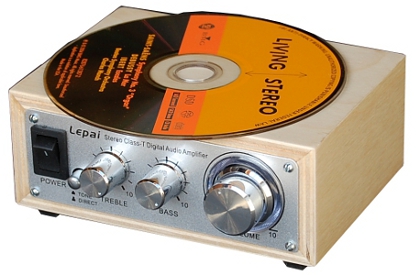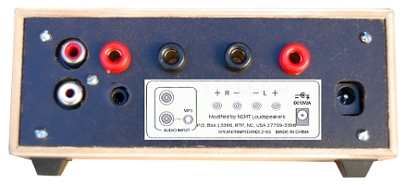|
|
You are reading the older HTML site
Positive Feedback ISSUE 66
lepai Modded Class T Amplifier as reviewed by Francisco Duran
It is almost intrinsic in audiophiles to constantly improve their gear and systems in one way or another, be it by tweaks of all kinds, or various add-ons, or the big one: buying new gear. Maybe that is why I have been a fan of modifications of high-end gear for years. Why not take that ultimate step and modify your gear? At least that will save you from buying new stuff every so many months. If you are not technically savvy, here is the point where a qualified and trained technician and or group of individuals that specialize in this field come in. And yes, there are stipulations in regards to modifications. How well is the original circuit implemented, were there cost cutting measures in the design and building of the equipment? Most equipment falls into the category of the second part of that last sentence. And does it really change the sound for the better replacing stock parts with exotic parts? Will my warranty be voided? From my experience with my own equipment, there are many more upgrades done to my gear than just parts swapping. I have had fantastic results having my gear modified by The Upgrade Company in Harbor Springs Michigan. Mr. David Schulte and crew have literally transformed my plain old Marantz Reference integrated amp and SACD player into formidable high end musical reproducing instruments. Think I am exaggerating? I challenge you to check his, or any other modification expert's website, call or send your gear in for a go around, and find out for yourself. Then get back to me and thank me. Or thank them. You will notice a change for the better. Done correctly modifications will almost always maximize the sonic potential of your gear. Which brings us to the component in question. One evening early in December 2012, while surfing the web, as if magnetically guided, I logged into the NSMT Loudspeaker website. I did a review of their 100M loudspeakers a few issues ago and I wanted to check with them and see what was new if anything. I scrolled to the bottom of the first page and on the right corner was a small surprise no bigger than your fist. It was a Lepai amplifier with a Tripath chip, but not just any old Lepai amplifier. This one had a beautiful wooden case. Okay, so what is the big deal you ask? Well this particular unit had been modified by NSMT. Much ink has been spilled on Tripath chip amps. For high-end audio interests anyway, it seems to all start with that plastic little jewel, the Sonic Impact amp and the Tripath chip that is inside it. Of which I am the proud owner of two of those cute little amps. At first the bane of the elite high-end audio class, chip amps have grown steadily in popularity. Researching Tripath on the web proved a bit tricky. Apparently Tripath went out of business in December 2007. From what I can gather Cirrus Logic bought the IP from Tripath and developed a version of the Tripath chip. But, like the old tube makers of yesteryear, as in Telefunken, Amprex, and RCA to name a few, Tripath apparently left a huge boatload of NOS Tripath chips behind. Tube lovers fear not. When buying an amp with a Tripath chip in it, you are most likely getting a genuine NOS chip. Amplifiers designed around this chip have a reputation for having clear sound, black background, a smooth warm character, very natural midrange, and solid bass. Have we been listening to the wrong amps or what? Indeed, Tripath chips have been used in products such as car stereos from Sony and Blaupunkt. Apple has used them in eMac's, iMacs, and G4cubes. Even high-end audio companies such as Sonneteer, Lehmann Audio, King Rex, and yes tube stalwarts Audio Research are guilty of this digital pleasure. So why did Mr. Erol Ricketts, owner of NSMT Loudspeakers, choose a Lepai amp instead of the many others on the market to modify? Besides it being built around a Tripath chip? I thought he would best be able to answer a few questions about this. F.D. Why did you choose the Lepai "chip" amp as opposed to other chip amps on the market to modify? E.R. I was looking for a small amp that I could pair with my small loudspeakers in order to offer my customers excellent desktop systems at a good price. I bought and tested over 10 different chip amps. What impressed me about this Lepai (I tested three different Lepai models, including this one) was the sound. Unlike most chip amps that are very thin in the low frequencies, this Lepai had very good dynamics for a rather incredibly low price. Moreover, it had tone controls and a tone control defeat switch which I think are indispensable for using the amp in a desktop system. The low price was important because it meant I could mod the amp and still sell it at a very reasonable price. The unmodified amp lacked smoothness and definition. In addition, the speaker connectors were not very good. And the presentation was poor. So those were the main areas that I focused on improving. F.D. How well does the Lepai do driving some of your speakers? E.R. The modified Lepai drives our speakers very well because all of our speakers are designed to have a fairly flat impedance curve which presents an easy load for the average small amplifier. Some of our loudspeakers are not highly efficient, but the Lepai drives them very well nonetheless because of the easy load their impedance presents to it. F.D. Are you planning modifications to other products? E.R. I have looked at some other amplifiers subsequently, but decided against further modifications. I have to remind myself that NSMT and Role Audio are loudspeaker companies, and fiddling with amplifiers is a distraction. So I have no plans to modify any other amps unless I stumble upon another gem like the Lepai. Thank you for taking the time to answer these questions Mr. Ricketts. The Lepai looks like the logical choice for this particular application. I feel very comfortable using this little amplifier in my main rig hooked up to either my Marantz amp, used as a preamp, or my Audio Limits passive. The music coming from these systems with the Lepai driving these speakers is very enjoyable. My stable of speakers are very efficient and have fairly even impedance curves with an 8 Ohm load, so I get more than adequate volume levels and the sound isn't half bad either. Even a pair of Fritz speakers with their 86dB efficiency proved no problem for the Lepai.
I have to agree with Mr. Ricketts on the point of tone controls. I find them very convenient from time to time, even on my Marantz Reference amp. Stock Lepai amps are sold by more than a few online companies. One of my favorites, Parts Express, sells this very amp, stock of course, plus a few iterations from the Lepai brand. There are Lepai amps with remote control, with USB, MP3, SD inputs, and even FM. The stock Lepai NSMT chose to modify is the LP-2020A+ Hi Fi Audio Mini Amp with power supply. The name sounds bigger than the amplifier itself. It has tone controls, on-off switch, and a volume knob with a bright blue ring around it on the front. On back there are spring clip speaker connectors, one set of RCA audio inputs, and one 3.5 input for an MP-3 player. I happen to own a Topping TP20 Mk2 for use with my computer. Topping also makes several models in various configurations using various versions of the Tripath chip. Some of them are the TA2020, TA2024, TA2022, and TA2021 to name a few. So, the choices are many for the adventurous music gear lover looking for inexpensive high quality amplification. The modified Lepai amplifier now sports a beautiful wooden case, the spring clips are now replaced by a pair of banana plug receptacles, and the 3.5 input is intact. The tone controls, on-off switch, and volume knob remain intact on the front panel. But of course, it is the modifications to the inside that counts in separating this amplifier from its toy contemporaries. So there I was in Lilliput land with three Tripath amplifiers on my gear rack. Instead of listening to the Lepai/NSMT amp on my desktop with my PC and Audioengine D1 headphone/USB DAC and B&W LM 1 speakers, I went straight for the gusto. I plugged the NSMP amp directly into my Upgrade Company Reference modified Marantz SA15S2 SACD player to either the Ascend Acoustics CB-170's, the Tonian Labs TL-D1's, or the Fritz stand-mounted into the amp. I used Tonian's pure copper cotton coated twisted pair speaker wire with Audioquest Z plug add on bananas for speaker cable, and Analysis Plus Solo Crystal One interconnects. Again, the preamp section of my Marantz PM15S1 integrated and Audio Limits passive were also installed from time to time. These were used mostly for either convenience, or break in. But it was with the amp hooked straight into the SACD player that proved the most revealing, and as it turned out, the most musically rewarding. As usual, over the course of this review a myriad of CDs, LPs, and movies were used. In order to get what this amp sounds like, I focused on several in particular which I have relied on before in previous reviews.
One of the first sonic characteristics this amp displayed was its dynamics. Spinning The CD Joyful Noise from Derek Trucks Band, "Lookout 31" was proof that will certainly raise the eyebrows for many audiophiles. This cacophonous track has many different sounds going on at the same time. Dynamics start and stop on a dime. I could follow any instrument seemingly up and down the musical scale effortlessly. There was no lagging in the timing of this music, especially the kick drum. This amp also responded to the subtle dynamic shadings of Doug McLeod's soft guitar picking and strumming on the tracks "Mystery Woman," and "Come to Find" on his Come To Find CD on XRCD. And on the track, "Bring It On Home" there is that blues kick drum again, sounding tight and explosive. The reproduction of dynamics from this amp was very clean and fast with a surprising amount of kick. I can see why Mr. Ricketts picked this little wonder to modify. A disk that brought me back to wandering around the Alexis Park hotel and so many Consumer Electronic Shows is The Ana Caram Collection on Chesky Records. If I am not mistaken I bought this CD at CES. This silky Brazilian singer glides through cuts like "Agua De Beber," "Meditation," and an old favorite "Samba De Verano." This disk displayed with ease the way this amp reproduced soundstage width, depth, and image placement. Again, here was a great surprise, an amplifier no bigger than my fist, hooked up to my Tonian floorstanders, churning out music and sounds commensurate with an amplifier many times its size and price. I love it! Deep, wide, soundstages, and solid image placements were easily reproduced with this modified chip amplifier. Many movies were played through this amp. On the great western, The Undefeated starring Clint Eastwood and Gene Hackman, I had the amp hooked to my Ascend Acoustics. In several of the scenes with thunder, my son and I heard taut, deep, fast dynamics, and low-end reproduction. Not only did the modded Lepai deliver, but the Ascends were surprising for a $350 stand mounted two-way in this regard. We heard dialogue that was crisp and clean and intelligible for a two-way system. Again, we heard a nice spread on the soundstage. The rain scene sounded as if the rain was falling in my listening room. The bass fiddles at the end of the movie didn't exactly shake the walls, but they sounded very solid and satisfying. This combination of amp and speaker provided a very enjoyable two-channel movie experience. If this all sounds too good to be true, let's put this into perspective. First off, let's start with my Marantz PM15S1 Reference amp modified by the Upgrade Company. When I put it back in my system, immediately noticeable was the smoother, more authoritative way it reproduced music. It has a noticeable grip, if you will, on the music. Details are easily fleshed out, as is the scale of the music, especially on big, orchestral recordings. In its defense, the modified Lepai sounded a bit more exciting, with a slightly hotter (but not bright) presentation than the smooth and big Marantz. To even compete with the Marantz is quite a feat. This little NSMT Lepai amp just kept coming across as very fun to listen to. I feel this to be a great strength for any amplifier, much less than one that costs less than a hundred dollars. Installing my regular desktop amp, the Topping TP20MK2, in the "big rig" was also fun. I have also used this amp to power my Tonian's and the Ascend Acoustic CB-170's from time to time with no sweat. First to suffer from the comparison was the bass. Although still surprising for this class of amp, the Topping displayed slightly less taut bass, with a slightly diffused character. The Topping was also slightly warmer with a roll-off in the top end. I noticed the midrange and upper-end dynamics to be slightly blunted and thicker. This sounds like I am describing the sound of an inexpensive tube amp. Yes, the Topping does lean in that direction. Easy to listen to and forgiving, with enough detail and bass to keep things interesting. Switching back to the NSMP Lepai we get a very clean and extended top end, taut extended bass, crisper and cleaner upper mids, and treble. Although not as warm as the Topping it makes up for it by having quick micro-dynamics, taut bass, and a more true timber. Instrument separation on the Trucks CD especially on "Lookout 31" sounded very good. The stock Lepai, with its stock power supply, sounded wispy on most dialog and vocals. Cymbals were also a bit chalky. The midrange, which is strong with these types of amplifiers, sounded pretty much tonally correct, aside from the wispy and slightly grainy characteristic noted. Bass is very good on the stock amplifier and an overall slight glare remains on the stock unit. I tried the modified Lepai with the stock power supply. Not because I am a glutton for punishment, but because I wanted to hear the difference for myself. I ordered my modded Lepai with the custom power supply, so I guess you could say that curiosity got the better of me. I had to hear the difference of the two power supplies for myself. To describe the performance with the stock power supply, it would be easier to describe what I heard when I switched to the custom power supply. The wispiness was gone, and the sibilance was controlled to the point of sounding more natural going from the stock Lepai to the modded one. The custom power supply only strengthened this. Bass definition and clarity, along with tonality and dynamics, were much improved. But the biggest improvement was the soundstage width and depth. It opened up considerably. Stage depth, width, and image placement was on a whole other level. This was cool! Changing the power supply was not a subtle difference. Images went from somewhat flat to having space around them. Images had more of a pinpoint placement. The soundstage was wider, taller, and deeper. Bass took on better definition. It was hard to believe. Whereas with the stock Lepai power supply Trucks guitar sounded plastic and peaky, with the mod it now sounded natural, clear, and tonally correct. With the custom power supply you also have the option to use your own two-prong C7 power cord. Switching in my Oyaide power cord for the stock one made a noticeable improvement. If I seem like I have gone on too long about these simple and inexpensive amplifiers, it is because they are so much fun to listen to and play with. For a long time I have read about the Tripath sound. But until I bought a couple of these amps I didn't realize how great they make music, and for so little expense. I have also read about their shortcomings. Mr. Erol Rickets has addressed these shortcomings very well in his modification to the Lepai Tripath amp. I gathered from his comments above that his primary intent was to have people use these amps in a desktop system. I never got there, installing them instead in my main system with great success. If you set them up correctly, for example use Z plugs for speaker connectors instead of trying to stick one half of an audio jewel spade lug in the speaker receptacle, and not hook them up to Maggies, you will find out how much fun this little amp will bring to you, and your music. A no brainer ever got more straightforward than this. Francisco Duran
Modified Lepai Amplifier
NMST
Loudspeakers
|










